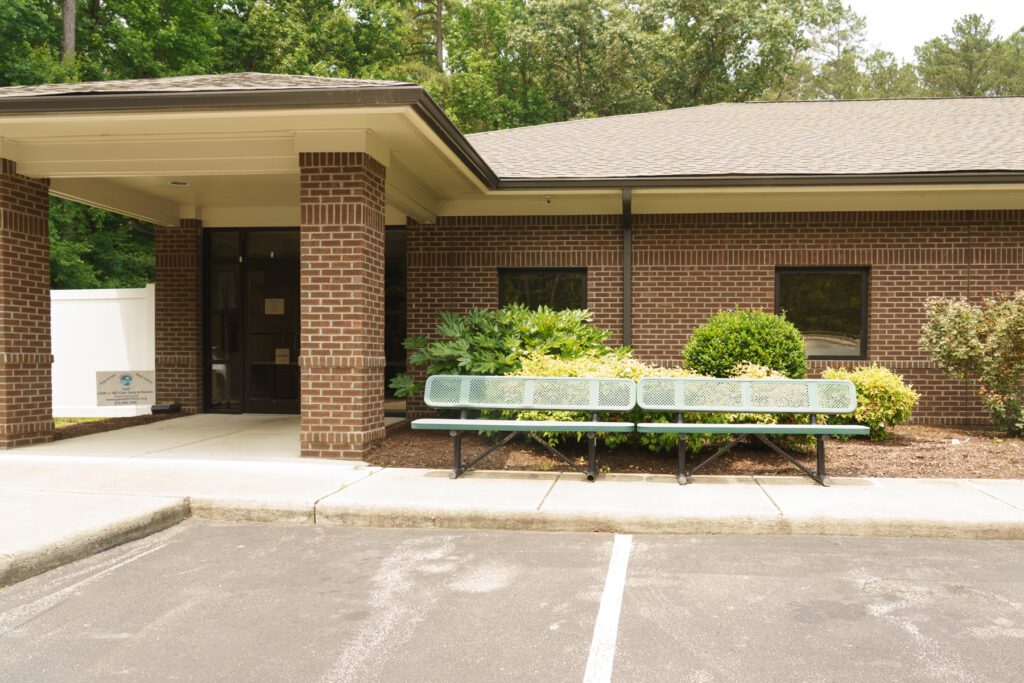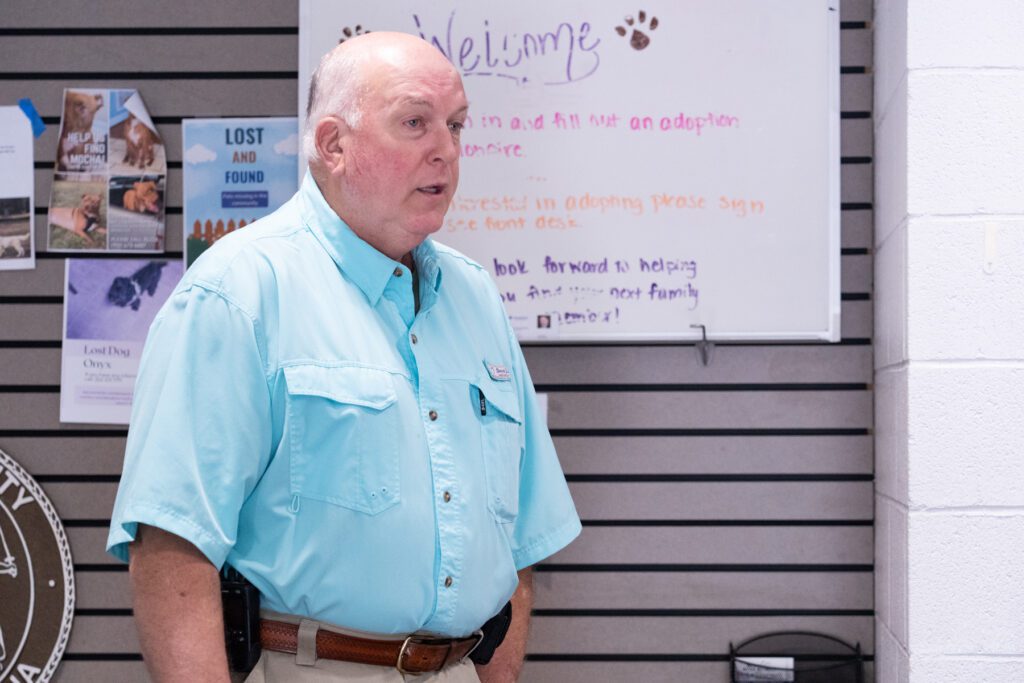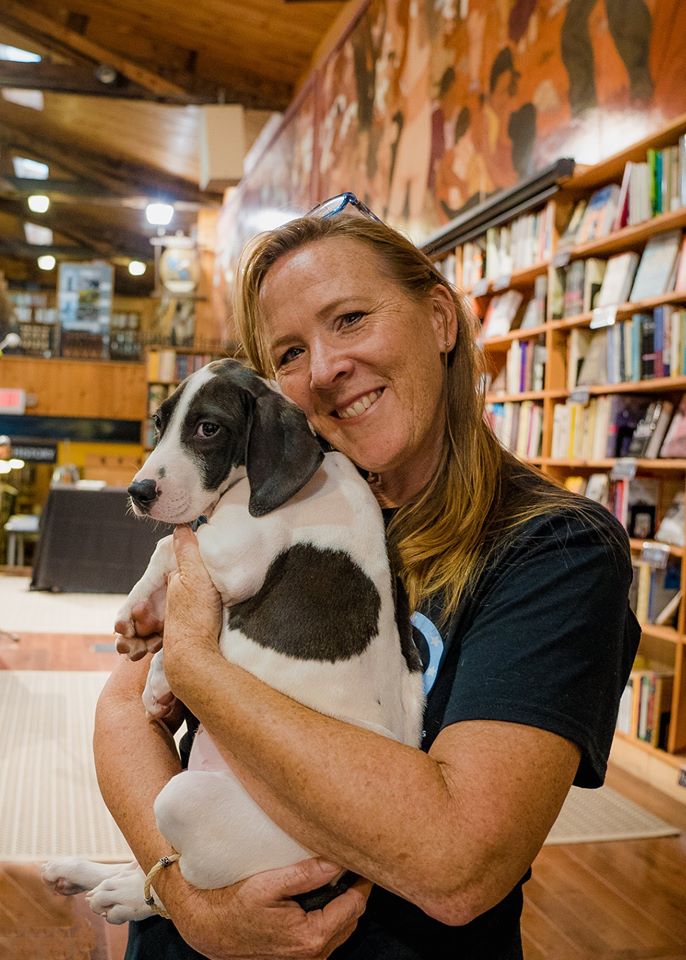In June, we visited Franklin County Animal Shelter in Louisburg, North Carolina. (This is our third ‘Franklin County’ if you’re keeping score.)

The shelter is in a period of transition with an interim director. Jerry Jones has lived his whole life in Franklin County. He’d been on the job for nine months. Prior to taking the shelter position, he had retired after serving as a deputy sheriff.

The shelter has been experiencing growing pains, much like the fast-growing Franklin County, which is absorbing much of the growth from nearby Raleigh.
Like many shelters across the country, the number of dogs coming in has also increased steadily since the COVID-19 pandemic. In the bright, spacious lobby, we met Jerry, along with Jessica, who is a project analyst for the county. She was brought in to develop new Standards of Practice and generally assist with the transition as the shelter brought many new staff members on board.
We also met Katie, who is the longest employee and has been here for five and a half years. She works admin now, but started as an Animal Caretaker. She likes her job and says it’s still the ‘dream job’ she thought it was when she started. Her knowledge and positive attitude have surely been a steadying influence through so much change.



For years, the shelter was under the Sheriff’s Department, and the history here seems to have been pretty bleak. Since moving under the leadership of the County Manager, though, things are improving, if perhaps, slowly. As Jerry said, “You can’t eat an elephant all at once. You got to do it in bites.”
The shelter has adopted new cleaning protocols and intake practices that result in healthier animals. Amber, the newest employee, began work a month or so ago. Her title is Outreach Coordinator, which is expansive. Fortunately, she is knowledgeable, experienced, and firmly dedicated to the shelter and its animals.
In addition to handling medical intake – vaccinating for distemper, Bordetella, and rabies, deworming, and testing for heartworm – Amber is also in the midst of developing a volunteer program. That volunteer program will be the key to so much for the shelter. Amber is evaluating applications and putting together a training program and volunteer manual. Once those pieces are in place, they will expand the program and welcome more volunteers. The handful of volunteers already helping at the shelter have been instrumental in getting dogs out for walks on the trail created through the woods behind the shelter building.
A mother/daughter team recently brightened up the look of the shelter with murals throughout the shelter.



All the dogs get out twice a day in the expanded outdoor play areas. We left them with a herding ball after meeting so many beautiful pittie-type dogs. The county is working on improvements to the ground cover, including a plan to put in artificial turf. The large room in the back of the building houses a huge incinerator that hasn’t been used in years. It is about to be removed, and pretty much everyone has ideas of what to do with the space.




Jerry would like to see the shelter expanded in many ways. While they need more space for the growing staff (currently all four ACOs share one small office), and more space to house animals well, he also wants to see it expand in its impact and involvement with the community. As the population grows, the tax base will grow too, and it could support improvements for the shelter and the animals. He believes it will happen, and no matter what his direct involvement is with the shelter when that time comes, he means to be sure it does.
The staff is working hard to make the most of what they have and develop programs to engage the community in the work. They’ve creatively placed some tough-to-adapt dogs, like a Belgian Malinois who is now serving on a sheriff’s department, and a boxer who had been here for six months and was finally adopted after Amber reached out to Carolina Boxer Rescue, and they shared his story.
Recently, the county commissioners approved the removal of ‘pull fees’ for rescues, which will hopefully lead to additional rescue partners transporting more dogs out of the shelter and saving more lives.
When I checked in with staff, Amber reported that the longest stay dogs, Duck-duck and Goose, two matching young hound dogs we met found homes shortly after our visit.



While in Louisburg, we also had the opportunity to meet with Ryan Preble, the county manager, to talk about the shelter and his hopes for its future.

We also met with a passionate group of advocates who are eager for the changes that are slowly coming. They are frustrated at being sidelined during the current transition. Like pretty much everyone we meet in rescue, they are outspoken in their desire to save more lives. They have a wealth of experience, energy, and knowledge, and there is no doubt that once invited back into the shelter, they will be an important part of this transformation story.



It’s clear that along with the growing pains for the shelter and the community it serves, there is also a challenge of moving past a hard history. Focusing on that history, though, isn’t how you solve a shelter crisis.
Hopefully, the staff, community, and leadership of Franklin County can put their energy towards moving forward together. They have all the pieces in place, now they just have to take it one bite at a time.
I wish every community had leadership, citizens, and shelter staff who are all striving for the same goal—creating a shelter that serves its community and offers the best possible care and outcomes for its animals.
I’m excited about the future at Franklin County Animal Shelter – its animals and its people.
If you’d like to help the Franklin County Shelter, consider shopping their Amazon Wishlist: https://www.amazon.com/hz/wishlist/ls/YEC357AWGAX1/.

Until each one has a home,
Cara
If you want to learn more, be sure to subscribe to our email list to get the latest stories and solutions delivered to your inbox. And help us spread the word by sharing this post with others. Visit our website to learn more.
You can also help raise awareness by following/commenting/sharing our content on Facebook, Instagram, YouTube, and TikTok.

Who Will Let the Dogs Out: Stories and Solutions for Shelters and Rescues was published in January of 2025. It is filled with stories and ideas to help everyone be part of the solution. You can buy a hardback or paperback copy for yourself and/or buy a copy for a shelter or rescue through our website. It is also available on Amazon in paperback and ebook. We are seeking opportunities to present the ideas from the book and facilitate discussions on how we can collaborate to find solutions for our shelters. If you have a dog-hearted group that would like to connect, contact Cara@wwldo.org.
To see our Emmy-nominated, award-winning short documentary, Amber’s Halfway Home, click here.
Did you know we have a podcast? I’m working at getting regular episodes up, including the audio version of the new book, and interviews with shelter heroes we meet. Find the podcast on Spotify and other podcast services.
For more information on any of our projects, to talk about rescue in your neck of the woods, or partner with us, please email cara@WWLDO.org.
For links to everything WWLDO, including volunteer applications, wishlists, and donation options, check out our Linktree.



Robin
Nice to see some forward progress!
Cara Achterberg
It is forward progress. And with municipal shelters, change often comes slowly and cautiously. They don’t have a great track record, so there is a lot of trust to build with the public. I’m hopeful this staff will work at that.
Cassandra
I see that you are still including some inaccurate info about Franklin County’s shelter intakes.
Dog intakes have NOT steadily increased since COVID. Annual intakes are around 1000 dogs for 2022, 2023, 2024. This is actually 300 to 400 fewer dogs annually than before COVID.
You can find this data here:
https://www.ncagr.gov/divisions/veterinary/aws/Fix/reports
Cara Achterberg
Thanks, Cassandra. We report what the shelter staff tells us. It’s helpful to have the government report here. Perhaps the staff’s words reflect the number of dogs they are called to take, but don’t have room to take. Shelters all over the country are turning away dogs in greater numbers this year (and for the last few years). That’s part of what is driving our stray population.